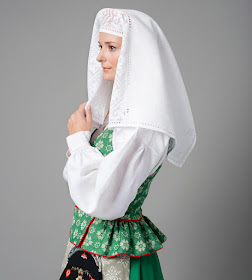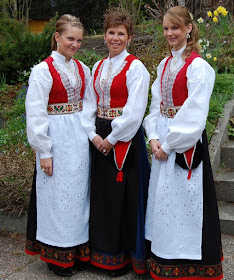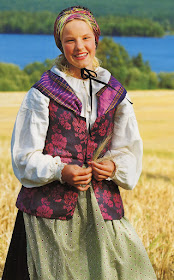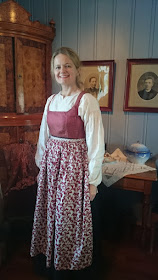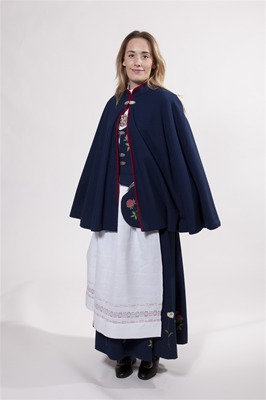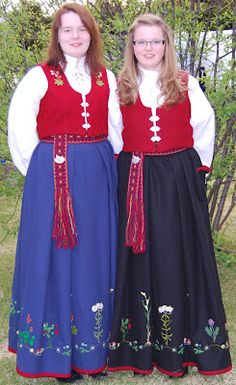Hello all,
Part three of this overview is forthcoming. I was asked about the costumes of Trondelag, and so I wrote this one first.
This is the fourth part of my overview of Norwegian Costumes. This will cover all of Norway from Trondelag north. Here Norway starts to overlap Sapmi, commonly called Lappland. I will not be covering the Saami costumes of Norway, as I have already written about them. They are a completely separate costume tradition, and it makes no sense to separate the part which is in Norway from the rest of Sapmi, which lies in Sweden, Finland, and Russia. While Trondheim is an old Norse city, Norwegian settlement becomes more recent the further north you go, and the costume tradition becomes very thin. The Norwegians are not indigenous to the north in the same way as they are to the south.
The National Bunad Council Bunad- og Folkedraktrådet , the authority on national costumes appointed by the government, has developed five categories to grade modern day bunads according to ‘authentic’ regional folk clothing:
Category 1 – a bunad that represents a ‘final’ link’ in the development of a folk costume. This is basically an original folk costume that has taken on the function of a bunad.
Category 2 – a bunad that has a background in a particular folk costume that is out of use but not forgotten. It is generally reconstructed from first-hand knowledge. Actual old garments exist.
Category 3 – a bunad that has been reconstructed from preserved folk garments which reflect the actual time and region of the piece. Pictures and writings are used as sources in reconstruction.
Category 4 – a bunad that has been made based on random and incomplete folk material. Missing pieces have been designed to match the style of the materials.
Category 5 – a bunad that has been completely or partially ‘freely composed’. It was the 1800s bunad movement that has given these types of bunad their status.
New ‘bunads’ that are being designed every year, must go through the strict judgement process of the National Bunad Council in order to be classified as a proper ‘bunad’. The council is very strict in making sure new additions follow closely the traditions and history of the area. Because of this, many designs today, even though they have the same function as a bunad, generally don’t make the cut and thus can not be called ‘bunads’. They receive the name drakt.
Costumes are readily available in Norway, there are many businesses which make them. These are called Husflid. They are, however, expensive, as the Norwegians believe in paying a living wage to people who do things like embroider or weave by hand. For every one of these costumes, whether bunad or drakt, there is at least one sewing house, or husflid, which specializes in making it.
All of the costumes from the north are either designed or reconstructed, with the single exception of the Røros region, where the costume tradition was still within living memory at the beginning of the 20th cent. The girls at the top of this article are in Røros costume.
Trøndelag
This area is centered around the city of Trondheim. It is currently split into two provinces.
https://en.wikipedia.org/wiki/Tr%C3%B8ndelag
There is a bunad which was designed for all of Trøndelag. cat. 4
Work on designing the costume started in 1920. It was based on various pieces which were found around the region. As it was intended to cover a large area, more variation was incorporated than was usual at that time. A couple of different aprons are used, and the colors were traditionally either blue, green or red. There is now a black and gold variant, and I have seen a photo of one in rust. Old photographs show a greater variety of material used. A veil may be worn over the cap.
South Trøndelag
South Trondelag has the richest costume tradition of any of the provinces which we will cover today. The map, like the one of Agder, shows white areas signifying unspecified costume traditions.
https://en.wikipedia.org/wiki/S%C3%B8r-Tr%C3%B8ndelag
The city of Trondheim has a drakt which was designed for it. It has not been approved as a bunad. cat 5
No comment.
Røros
This is a mining area, and the southern edge of Sapmi. The costumes can be made in a wide variety of colors and fabrics. The girl's costume is distinct from that of married women. They still wear a jacket as part of the formal bunad. There are three regions in this district, Røros itself, Haltdalen and Tydal.
Røros
cat 2
https://www.youtube.com/watch?v=PGBSxeNNcxo
There is an embroidered bunad which was designed for this area, called the Bergstadbunad. It features embroidery of some of the local wildflowers.
cat.5
Haltdalen
This costume is very similar to that of Roros. cat 4
Tydal
This is part of the Roros district, the bunad is somewhat distinct, but still similar. cat 4
Selbu
This costume features embroidered caps, pockets and shawls. The bodice and vest are of block printed cloth. cat 3
Gauldal
cat 4 mens bunad only
Oppdal
cat 4
Rennebu and Meldal
men cat 3
Rennebu Womens bunad
cat 4
Meldal Womens bunad
cat 4
Orkdal
cat 3
Orkdalsdrakt
This is a designed embroidered costume for Orkdal
cat 5
Orkladalen
This is another reconstructed bunad for the three previous districts of Sennebu, Meldal and Orkdal, which formed the ancient kingdom of Orkladalen.
Hitra
This is an island near the south border of South Trondelag. This drakt is based on an old drawing.
cat 4
Fosen
Fosen lies north of the Trondheim fjord, and has land borders only with North Trondelag, but is jurisdictionally part of South Trondelag. The bunad is very similar to that of North Trondelag. It features a quilted skirt, and seems to be based at least in part on the drawing just above.
cat 3
North Trøndelag
This area is much less populated than South Trondelag. There are only three bunads and a couple of drakts from this province.
North Trondelag embroidered bunad. Also called the Floan bunad.
This was put together in 1938. It seems to feature four different possible embroidery patterns.
cat 4
North Trondelag reconstructed bunad. This represents the 1700s.
This was presented in 1992.
cat 3
Namdalen
Namdalen is close to the coast, next to Fosen. This bunad was designed in 1950.
women 4, men 3
Leksvik
Leksvik is on the north bank of the Tronderfjord across from Trondheim. This drakt was designed in 1992 and features embroidery of wildflowers. There are 4 variants.
cat 5
Mosvik
Mosvik is next to Leksvik, just up the fjord. This drakt is a free composition.
cat 5
Overhalla
Overhalla is further north, just past Namdalen. The embroidery on this drakt was taken from a bridal skirt found in the area.
cat 5
Nordland
The climate here is remarkably temperate, with some of the few temperate rain forests that can be found in Europe. The fisheries are exceptionally rich.
https://en.wikipedia.org/wiki/Nordland
The Nordland bunad comes in inland and coastal variants, green and blue, respectively. The embroidery and cut come from garments found in Vefsn. It was designed in 1928
cat 5
The Mens bunad is also used in Troms
cat 4
Vega
This is a group of islands in the south of Nordland. This drakt was a free composition in 1995.
cat 5
https://en.wikipedia.org/wiki/Vega,_Norway
Hamarøy
This municipality is in the north of Nordland. This bunad was designed in 1939.
women cat 4, men cat 5
https://en.wikipedia.org/wiki/Hamar%C3%B8y
Ofoten
Ofoten is a district in the northeast corner of Nordland. The bunad was based on several garments from the area, including an embroidered apron which was found in Canada. The floral embroidery on the apron was added by the designers. The design was finished in 1989.
cat 5
https://en.wikipedia.org/wiki/Ofoten
Lofoten
Lofoten is a district in the north of Nordland, consisting of a peninsula and a large group of islands. The bunad was designed in 1942
cat 5
https://en.wikipedia.org/wiki/Lofoten
Troms
This province lies completely north of the Arctic Circle.
https://en.wikipedia.org/wiki/Troms
Troms bunad
This features the weaving tradition of the area. It was designed in 1967
cat 4
Troms Festdrakt
This was a free composition based on the folk embroidery of Troms.
cat 5
The rest of the costumes of this province are connected to particular districts. There are a remarkable number of small communities which have designed their own costumes.
Bardu and Målselv
These two districts are in the southeast of Troms. They were first settled by Norwegians in 1788. The Saami call the area Bearddu. Since many of the early settlers came from Gudbrandsdal, it was decided to model the bunad for this area on the Gudbrandsdal bunad. The design of the bunad was finished in the 1960s.
cat 5
https://en.wikipedia.org/wiki/Bardu
Balsfjord
This municipality lies just north of Malselv. It is a fertile region that lies between two fjords. This bunad was finished in 1979. It features a cap for girls and a kerchief for married women.
cat 5
https://en.wikipedia.org/wiki/Balsfjord
Malangen
This was a former municipality centered around the Malangen fjord, which lies between Balsfjord and Lenvik. The territory has since been divided among neighboring districts.
The drakt was designed to represent the culture and nature of the area, including a stylized letter M.
cat 5
https://en.wikipedia.org/wiki/Malangen
Lenvik
Lenvik district is west of Balsfjord, split between the mainland and the island of Senja. The drakt was composed in 1981 and aggressively features dandelions in its embroidery and silver jewelry.
cat 5
https://en.wikipedia.org/wiki/Lenvik
Senja
Senja is an island off the southern coast of Troms, it is split between four municipalities, one of which is Lenvik. The drakt was designed in 1978 and the style of the 70s is evident. It features either a brown bodice or a red one.
cat 5
https://en.wikipedia.org/wiki/Senja
Tromsø
This is the next municipality north along the coast, including the city of Tromsø and the island of Tromsøya along with other islands and a big chunk of the coastline. The drakt features embroided Queen Anne's Lace.
cat 5
Karlsøy
This is the next municipality as we continue north along the coast. It is made up of islands.
My sources disagree whether this is a bunad or a festdrakt. It features naturalistic floral embroidery. It comes in blue or red.
cat 5
https://en.wikipedia.org/wiki/Karls%C3%B8y
Helgøy
This is a former municipality which is currently incorporated into Karlsoy. The actual village of Helgoy is no longer inhabited. The drakt features embroidery of one specific plant, the Northern Dock, Rumex longifolius. I do not know why this plant was considered significant. The design was completed in 2000.
cat 5
https://en.wikipedia.org/wiki/Helg%C3%B8y
Skjervøy
This is the next municipality as you continue north. It also consists of a group of islands. This costume was designed by Dagmar Haugberg. My sources disagree as to whether this is a bunad or a drakt.
cat 5
https://en.wikipedia.org/wiki/Skjerv%C3%B8y
Lyngen
This municipality lies on a peninsula to the south of Skjervoy. This drakt was designed in 1985.
cat 5
https://en.wikipedia.org/wiki/Lyngen
This image shows the Nordland bunad on the left, and the Lyngen festdrakt on the right.
Kåfjord
This municipality lies east of Lyngen on the mainland. The bunad was a free composition which took its inspiration from the natural richness of the area.
cat 5
https://en.wikipedia.org/wiki/G%C3%A1ivuotna%E2%80%93K%C3%A5fjord
Nordreisa
This district lies northeast of Kafjord.The costume, called a bygdedrakt, is an attempt to reconstruct the historical clothing of the area.
cat 5
https://en.wikipedia.org/wiki/Nordreisa
Kvaenangen
This district lies at the northeast end of Troms, next to Finnmark. The name means Kven Fjord. Most people in this area now consider themselves to be Norwegian, although the majority are of Saami or Kven ancestry. The bunad was a free composition in 1996.
cat 5
https://en.wikipedia.org/wiki/Kv%C3%A6nangen
Kven
The Kven are an ethnic minority in Troms and Finnmark, as well as adjacent parts of Sweden. They are descended from Finnish settlers who came to the area in the 18th and 19th cent. Their drakt reflects their Finnish heritage. Some of them still speak their distinctive dialect.
In this image, a Kven couple poses with a family in the Nordreisa bygdedrakt.
Finnmark
This is the largest and least populated province of Norway. In the interior, the Saami are the majority, while on the islands, the Norwegians are. The fjord areas are mixed.
https://en.wikipedia.org/wiki/Finnmark
Finnmark has several Saami costumes which are very much alive, but there is only one Norwegian bunad and two drakts for this area.
Finnmark bunad
This bunad was designed in 1967. There was little native material to go on, but the hat was traditional. Notice the pendant which is attached to the bodice.
cat 5
Finnmark Festdrakt
This is a free composition based on the sewing traditions of Finnmark.
cat 5
Vardø
This municipality is the furthest east in Norway.This drakt was designed to symbolize the area.
cat 5
https://en.wikipedia.org/wiki/Vard%C3%B8
Svalbard
Svalbard is a group of islands which lies far north of the Arctic circle. It had no human inhabitants until modern times. It is now under Norwegian jurisdiction. It has the northernmost permanent civilian population of any settlement in the world.
https://en.wikipedia.org/wiki/Svalbard
The tradition is that only those who have spent all four seasons on Svalbard are permitted to wear this bunad. cat 5
This concludes my overview of Norwegian costume. I will return to look at individual costumes in more detail.
Thank you for reading. I hope that you have found this to be interesting and informative.
Roman K.
email - rkozakand@aol.com
Source Material:
Aagot Noss, 'Draktskikk i Aust-Telemark', Oslo, 2010
Kari-Anne Pedersen, 'Folkedrakt blir Bunad', Cappelen Damm, 2013
Bjorn Sverre hol Haugen, 'Norsk Bunadleksikon' Oslo, 2009
Kjersti Skavhaug et al, 'Norwegian Bunads', Oslo, 1991
Heidi Fossnes, 'Norges Bunader og Samiske Folkedrakter', Oslo, 1993
Ellen Scheel et al, 'Bunad-Brodering', Oslo, 1997
Janice Stewart, 'The Folk Arts of Norway', University of Wisconsin, 1953
Guvnor Traetteberg, 'Folk Costumes of Norway', Oslo, 1966, 1976
Thorbjorg Ugland, 'A Sampler of Norway's Folk Costumes', Oslo, 1996
Laila Duran, 'Scandinavian Folklore vol I - III', Sweden, 2011-2013









